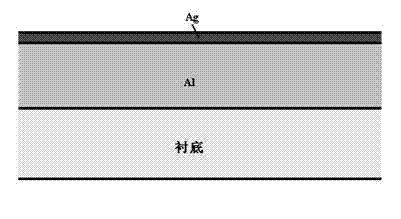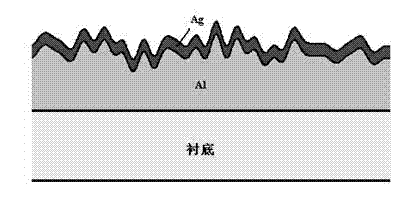Back scattering surface of thin-film silicon solar cell and preparation method of back scattering surface
A solar cell and backscattering technology, which is applied in circuits, photovoltaic power generation, electrical components, etc., can solve problems such as difficulty in realization, and achieve the effects of reducing production costs, improving optical and electrical properties, and simplifying processes
- Summary
- Abstract
- Description
- Claims
- Application Information
AI Technical Summary
Problems solved by technology
Method used
Image
Examples
Embodiment 1
[0040] Using the physical vapor deposition method (double-boat dual-source evaporation process), in a high-vacuum environment: under the condition of heating the glass substrate to 250°C, first deposit an Al film with a thickness of 400 nm on the substrate, and then deposit a thickness of The Ag film at 20 nm constitutes an Al / Ag composite film, that is, a roughened backscattering surface. Such as image 3 As shown, it can be seen that the surface of the film presents a submicron-scale structural morphology.
Embodiment 2
[0042] Using the physical vapor deposition method (double-boat dual-source evaporation process), in a high vacuum environment: at room temperature, an Al film with a thickness of 400 nm is deposited on a glass substrate, and then an Ag film with a thickness of 50 nm is deposited. The Al / Ag composite film is formed, and then the deposited composite film is subjected to vacuum heat treatment at 250° C. to make a roughened back-scattering surface. Such as Figure 4 As shown, it can be seen that the surface of the film presents a submicron-scale structural morphology.
Embodiment 3
[0044] Using the physical vapor deposition method (double-boat dual-source evaporation process), in a high-vacuum environment: under the condition of heating the glass substrate to 150°C, first deposit a Sn film with a thickness of 400 nm on the substrate, and then deposit a thickness of The Ag film at 30 nm constitutes a Sn / Ag composite film, that is, a back-scattering surface with roughened surface. Such as Figure 5 As shown, it can be seen that the surface of the film presents a micron-scale structural morphology.
PUM
 Login to View More
Login to View More Abstract
Description
Claims
Application Information
 Login to View More
Login to View More - R&D
- Intellectual Property
- Life Sciences
- Materials
- Tech Scout
- Unparalleled Data Quality
- Higher Quality Content
- 60% Fewer Hallucinations
Browse by: Latest US Patents, China's latest patents, Technical Efficacy Thesaurus, Application Domain, Technology Topic, Popular Technical Reports.
© 2025 PatSnap. All rights reserved.Legal|Privacy policy|Modern Slavery Act Transparency Statement|Sitemap|About US| Contact US: help@patsnap.com



